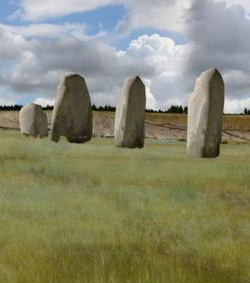Henge find sheds new neolithic light
 Archaeologists may have spotted the buried remains of a giant prehistoric monument close to Britain's famous Stonehenge.
Archaeologists may have spotted the buried remains of a giant prehistoric monument close to Britain's famous Stonehenge.
Ground-penetrating radar surveys have found evidence of up to 90 standing stones, buried for millennia under a bank of earth.
They estimate that some of the stones would have stood 4.5 metres when first put in place some 4,500 years ago.
The so-called ‘superhenge’ site is located at Durrington Walls, less than three kilometres from Stonehenge.
It measures 500 metres across and more than 1.5 kilometres in circumference, and could originally have comprised up to 200 stones.
“Durrington Walls is an immense monument and up until this point we thought it was merely a large bank and ditched enclosure, but underneath that massive monument is another monument,” Vincent Gaffney, of the University of Bradford, told the BBC.
The team behind the project came from the Stonehenge Hidden Landscapes Project - a collaboration between the University of Birmingham and the Ludwig Boltzmann Institute for Archaeological Prospection and Virtual Archaeology (LBI ArchPro) in Vienna.
The team believes the stones may have toppled over in order for the bank of the later Durrington Walls henge to be built over them.
Project initiator Wolfgang Neubauer, director of the LBI ArchPro, called it a “very important and fantastic finding”.
“The missing stones might be the stone material which was used later on to build Stonehenge,” he explained.
He also said those that have been left in place probably broke during attempts to move them.
“This discovery of a major new stone monument, which has been preserved to a remarkable extent, has significant implications for our understanding of Stonehenge and its landscape setting,” Professor Gaffney said.
“Not only does this new evidence demonstrate a completely unexpected phase of monumental architecture at one of the greatest ceremonial sites in prehistoric Europe, the new stone row could well be contemporary with the famous Stonehenge sarsen circle or even earlier.”








 Print
Print